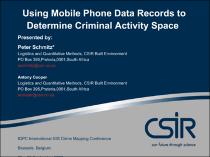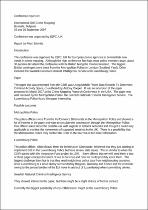JavaScript is disabled for your browser. Some features of this site may not work without it.
- ResearchSpace
- →
- Research Publications/Outputs
- →
- Conference Publications
- →
- View Item
| dc.contributor.author |
Schmitz, P

|
|
| dc.contributor.author |
Cooper, Antony K

|
|
| dc.date.accessioned | 2007-10-03T08:20:15Z | |
| dc.date.available | 2007-10-03T08:20:15Z | |
| dc.date.issued | 2007-09 | |
| dc.identifier.citation | Schmitz, P and Cooper, AK. 2007. Using mobile phone data records to determine criminal activity space. IQPC International GIS Crime Mapping Conference, Brussels, Belgium, 25-26 September 2007, pp 1-29 | en |
| dc.identifier.uri | http://hdl.handle.net/10204/1273 | |
| dc.description | 2007: IQPC International GIS Crime Mapping Conference | en |
| dc.description.abstract | Crime in most cases occurs close to the offenders anchor point. The number of crimes committed by an offender decreases with distance form ones anchor point. Crime types dictate the distance from the anchor points; violent crime tends to be closer to anchor points than property crimes. Using call data records (CDR) or active tracking data makes it possible to determine the activity space of an individual using cellular data. The data alone is not sufficient and needs to be supported by local knowledge and gathered intelligence. SAPS indicates that it will drastically improve their targeted intelligence gathering based on the analysis done using CDR or results from the active tracking of the handset of a suspect. The analysis offers the investigating team an effective method to brief a new unacquainted investigating officer who joined the investigation with regards to the suspect’s activity space, and anchor points. SAPS mentioned that the active tracking of a suspect can help the investigators to establish a finer detail on specific movements than what the CDR can provide. They will use the results of the CDR analysis to guide active tracking exercises. It is strongly recommended that the above should be used for the prosecution purposes, but only for assisting in solving a criminal case. Forensic mapping of call data records can be used for prosecution purposes | en |
| dc.language.iso | en | en |
| dc.subject | Activity space | en |
| dc.subject | Mental maps | en |
| dc.subject | Mobile phone data | en |
| dc.subject | Journey to crime | en |
| dc.subject | Cell network | en |
| dc.title | Using mobile phone data records to determine criminal activity space | en |
| dc.type | Conference Presentation | en |
| dc.identifier.apacitation | Schmitz, P., & Cooper, A. K. (2007). Using mobile phone data records to determine criminal activity space. http://hdl.handle.net/10204/1273 | en_ZA |
| dc.identifier.chicagocitation | Schmitz, P, and Antony K Cooper. "Using mobile phone data records to determine criminal activity space." (2007): http://hdl.handle.net/10204/1273 | en_ZA |
| dc.identifier.vancouvercitation | Schmitz P, Cooper AK, Using mobile phone data records to determine criminal activity space; 2007. http://hdl.handle.net/10204/1273 . | en_ZA |
| dc.identifier.ris | TY - Conference Presentation AU - Schmitz, P AU - Cooper, Antony K AB - Crime in most cases occurs close to the offenders anchor point. The number of crimes committed by an offender decreases with distance form ones anchor point. Crime types dictate the distance from the anchor points; violent crime tends to be closer to anchor points than property crimes. Using call data records (CDR) or active tracking data makes it possible to determine the activity space of an individual using cellular data. The data alone is not sufficient and needs to be supported by local knowledge and gathered intelligence. SAPS indicates that it will drastically improve their targeted intelligence gathering based on the analysis done using CDR or results from the active tracking of the handset of a suspect. The analysis offers the investigating team an effective method to brief a new unacquainted investigating officer who joined the investigation with regards to the suspect’s activity space, and anchor points. SAPS mentioned that the active tracking of a suspect can help the investigators to establish a finer detail on specific movements than what the CDR can provide. They will use the results of the CDR analysis to guide active tracking exercises. It is strongly recommended that the above should be used for the prosecution purposes, but only for assisting in solving a criminal case. Forensic mapping of call data records can be used for prosecution purposes DA - 2007-09 DB - ResearchSpace DP - CSIR KW - Activity space KW - Mental maps KW - Mobile phone data KW - Journey to crime KW - Cell network LK - https://researchspace.csir.co.za PY - 2007 T1 - Using mobile phone data records to determine criminal activity space TI - Using mobile phone data records to determine criminal activity space UR - http://hdl.handle.net/10204/1273 ER - | en_ZA |







